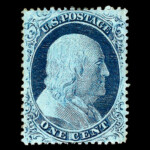United States Stamp Scott #9, part of the One Cent blue issue from 1851-57, holds a unique position in American philately. The stamp is a product of a series of design and production complexities inherent in the mid-19th century stamp manufacturing process. It is distinguishable from other stamps in the same series by specific design features, most notably its Type IV classification. This stamp, along with its counterparts, was primarily intended for standard postal use, adhering to the postal rates and regulations of the time. However, its variety in types and subtypes elevates its historical significance, providing an extensive field for philatelic study and research.
Design & Print
Scott #9 was printed by the firm Toppan, Carpenter, Casilear & Co., following the Congressional act of March 1851 which necessitated the production of new stamps to align with revised postal rates. The stamp, issued on June 1st, 1852, emerged from Plate I late (reconstruction), with 199 of the 200 positions on the plate undergoing recuts. This meticulous process was essential to fit the elaborate design onto the plate. The stamp’s design, predominantly a Type IV, is characterized by incomplete top and bottom designs, with specific alterations in the balls and plumes, and recuts in both the inner and outer frame lines. This intricate design was part of the effort to accommodate the stamp’s dimensions within the plate’s constraints.
Postal Usage
The Scott #9 stamp, with its denomination of one cent, was an integral part of the postal system during its period of circulation. It catered to the revised postal rates established in July 1851. This legislative change, which reduced postage rates, was a significant step in American postal history, reflecting the evolving nature of mail distribution and its accessibility to the general populace. The stamp’s usage was thus widespread, facilitating everyday mail transactions across the country. Its design and denomination were directly influenced by these new postal requirements, underscoring the dynamic relationship between postal legislation and stamp design.
Identification
Identifying Scott #9 requires a keen eye for specific design details that distinguish it from similar stamps in the series. As a Type IV design, it is marked by the incomplete balls and plumes at the top and bottom, with a complete outer frame line and a recut inner frame line at these locations. The top and bottom frame lines appear darker and heavier than the rest of the lines in the design, or compared to the other Types that have top and bottom frame lines, such as Scott #7 Type II.
The subtle nuances in the recuts and erasures are critical in distinguishing it from other types. Additionally, the double and triple transfers present in certain positions on the plate add another layer of complexity to its identification. These characteristics are not only vital for the proper classification of Scott #9 but also serve as an indicator of the meticulous craftsmanship and technical challenges of stamp production in the 1850s.















































Ask A Question Or Leave A Comment